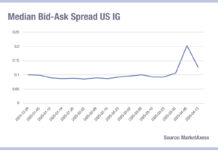By Pia Hecher.
Intercontinental Exchange (ICE) Data Indices, the information provider, has reported that the total outstanding debt across global bond markets only grew by 4.6% in 2018 with a net increase of US$2.9tn versus a year ago. Emerging market (EM) local sovereign growth continued to rise faster than its developed market (DM) equivalent, increasing the EM share of the local Sovereign sector to 12.8% from 12.0% a year ago, ICE stated.
In its report on world bond market growth trends, ICE announced that bond markets only grew by 4.6%, 0.1% more in 2018 than in 2014 when the lowest reading of the last 22 years took place. The reduced growth rate in 2018 caused flat or negative return rates in many parts of fixed income markets, while bond yields reached their highest level in seven years, according to ICE.
ICE noted that EM local sovereign growth remained higher than its DM counterpart, as EM growth was almost three times bigger than that of DM countries (12.4% vs. 4.5%) in 2018. Because all DM growth came from the US, the US share of the local sovereign sector expanded to 36.8%, reaching its highest allocation in 20 years, ICE reported.
A “risk-off” mentality caused high yield new issuance to be 39% lower than in the previous year, according to ICE. As the high yield component contracted, corporate growth slowed down. The firm argued that high grade corporate growth was reduced to 6.1% in 2018, only to be trumped by high yield corporate contraction at -7.9%.
On a more positive note, ICE stated that the securitised/collateralised sector showed signs of life after dwindling in the post-financial crisis era. Within the sector, US asset backed securities grew most, reaching 14.3% year-over-year (YOY). After four years of negative growth, commercial mortgage-backed securities (CMBS) increased by 9.3%, ICE reported.
The firm concluded that the decline of the US Agency Index continued in 2018, driving a 0.8% decrease in outstanding debt YOY of the US dollar (USD) component of the external sovereign and quasi-government sector. In contrast, the US municipal bond market has been mostly flat in the past years and foreign governments carried on issuing a growing amount of USD-denominated debt.
©TheDESK 2019
©Markets Media Europe 2025

























